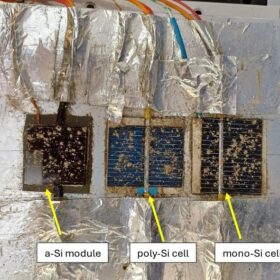Overhead vs. vertical agrivoltaics
A survey conducted by Dutch researchers has compared the visual impact of overhead and vertical agrivoltaics farms on nearby residents and has found that vertical arrays look less invasive.
Dubai’s high-rise buildings perfect match for building-integrated photovoltaics
Scientists in the Middle East have simulated the use of different building-integrated PV systems on Dubai’s high-rise buildings. They found that for buildings with more than seven floors, BIPV may be superior to rooftop power generation.
Investigating smoke dispersion in rooftop PV fires
Researchers have conducted a small-scale experiment on the behavior of smoke in PV-related fires. They have found that in homes featuring rooftops with a pitch of less than 45 degrees, residents only have about four minutes to safely evacuate.
New approach to integrate PV-powered heat pumps into greenhouses
Scientists have proposed to use PV energy and heat pump-driven HVAC system in greenhouses conceived to grow tomatoes in the Mediterranean area. The system was found to have a payback time of only 2.9 years in southern Spain.
The effect of extreme dust conditions on PV system performance
Scientists in Romania have found that extreme dust conditions may cause losses of 45.35% and 38.14% in maximum power and short-circuit current under outdoor conditions for different kinds of solar modules. They warned that, if the effects of climate change escalate, resulting in less rainfall and more frequent sandstorm events originating from the Saharan region, extreme scenarios are very likely to occur in Europe.
Coupling ground-source heat pumps with heat storage, borehole heat exchangers
Scientists from China have developed a novel optimization method for medium-depth ground source heat pumps, using an improved chaos particle swarm optimization. They coupled it with either a heat storage tank or a shallow borehole heat exchanger and found that both system typologies increase the heat pump’s coefficient of performance.
The solar rebound effect in residential PV
The rebound effect consists of a reduction in expected gains from a more resource-efficient technology as a result of behavioral or systemic change. An international research team has investigated this phenomenon in the residential PV segment in Vietnam and has found that it could happen in any country where the policy supporting solar power is not fully and scientifically explained.
Hybridizing PVT energy with heat pumps, borehole storage
A European research group has tested an energy system combining PVT collectors, a water-to-water heat pump and borehole thermal energy storage in an Italian swine farm and has found the proposed system can completely replace fossil fuel-based power generation.
Deye releases new 50 kW/61.4 kWh battery
Chinese inverter manufacturer Deye has developed a new all-in-one energy storage system (ESS) with 50 kW of output and 61.4 kWh of storage capacity. It features LiFePO4 batteries with a maximum temperature of less than 40 C.
New CIGS solar cell design with antimony trisulfide promises 31.15% efficiency
The novel solar cell uses antimony trisulfide (Sb2S3) as the back surface field (BSF) layer. According to its creators, this layer can be included in conventional CIGS solar cells to improve their efficiency and reduce the absorber material’s cost.










